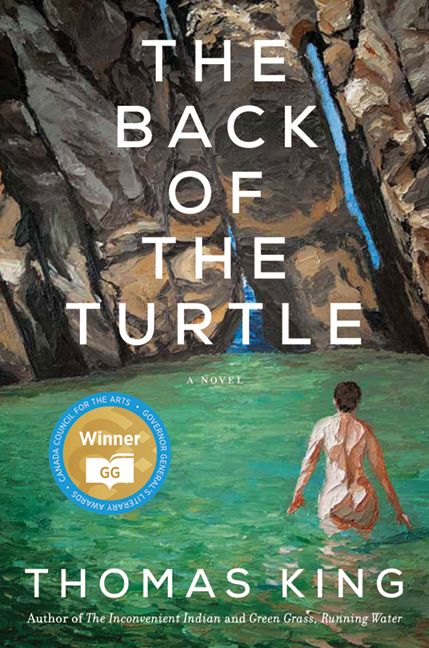Table of Contents
ToggleIntroduction
The Back Of The Turtle Novel Summary By Thomas King The Back of the Turtle is a book that explores the past and the hardships of Indigenous cultures while addressing numerous current challenges. The Indigenous notion that the planet rests on the back of a gigantic turtle is referenced in the title itself. This idea is sometimes taken to mean that the Earth is a living, breathing, interconnected organism. King’s book depicts the repercussions of human disdain for the environment and its effects on the natural world, especially in Indigenous lands, by placing this historic image within the framework of contemporary ecological catastrophe.
The novel is set in a fictional town called Deseronto, where a major environmental disaster—one that involves a toxic spill in a nearby river—has altered the landscape and disrupted the lives of its inhabitants. The town’s inhabitants, who include Indigenous and non-Indigenous characters, are all affected by the ecological devastation, and their stories intersect in unexpected ways.
Thomas King’s distinctive narrative style, marked by humor, irony, and a subtle sense of the surreal, invites readers into a world where the spiritual and physical realms collide, where characters grapple with their identities, and where the land itself is a character in the story. As a seasoned storyteller, King employs elements of magical realism, allowing for moments of surrealism to underscore the novel’s larger social and ecological themes.
Plot Summary
The Destruction of Deseronto: The novel begins with the devastating environmental disaster in the small fictional town of Deseronto, Ontario. A chemical spill from a nearby corporation has poisoned the water and land, leading to the destruction of the ecosystem and the collapse of the local community. The spill has wiped out the local wildlife and fish population, contaminated the soil, and made the once-thriving region uninhabitable. The environmental damage also causes severe health problems for the people living in the town, many of whom now face illnesses linked to the contamination.
This catastrophe not only damages the environment but also brings into sharp focus the historical wounds and injustices faced by Indigenous communities in Canada. Deseronto, once a place of vibrant Indigenous cultures, has now become a symbol of exploitation, environmental destruction, and the erosion of Indigenous land and life. The spill serves as a metaphor for the broader cultural, economic, and environmental exploitation that Indigenous peoples have experienced for centuries.
The Main Characters: Several key characters play central roles in The Back of the Turtle, and each of them is grappling with their own struggles as they try to make sense of the ecological disaster and their individual roles in the larger narrative.
- Gabriel: Gabriel is a scientist who works for the corporation responsible for the toxic spill. He is a man of science and reason, but his personal life is marked by trauma and guilt. The story follows Gabriel as he returns to Deseronto after the disaster in an attempt to make amends for the role he played in the spill. Gabriel’s character is emblematic of the tension between personal responsibility and the corporate forces that drive environmental destruction. His journey throughout the novel is one of introspection, guilt, and the search for redemption.
- Turtle: Turtle is one of the most mysterious and significant characters in the novel. She is a woman who has experienced immense personal suffering, including the loss of her family. In her grief and solitude, Turtle embarks on a journey of self-healing and discovery, driven by her connection to the land and the stories passed down through her ancestors. Her character serves as a vehicle for King’s exploration of Indigenous spirituality, as she navigates the devastating impacts of colonialism and environmental destruction.
- Lazarus: Lazarus is an Indigenous elder who is trying to hold the remnants of his community together in the face of the disaster. He represents the wisdom and resilience of Indigenous peoples, as well as the ongoing struggle for survival in a world that continues to be hostile and unyielding. Lazarus’s role in the novel is to bridge the gap between past and present, helping others to see that healing and reconciliation are possible, even in the face of overwhelming loss.
- The Corporation and Its Executives: The corporation that is responsible for the chemical spill is also an important presence in the novel, representing the corporate greed and disregard for the environment that has led to the devastation. The executives are portrayed as morally ambiguous characters who, while seemingly indifferent to the damage they’ve caused, are also struggling with their own personal demons and guilt.
Themes of Environmental Destruction and Redemption: As the narrative progresses, Gabriel, Turtle, Lazarus, and other characters attempt to make sense of the environmental catastrophe that has affected Deseronto. Gabriel’s scientific knowledge and his efforts to stop the further contamination of the area lead him to a deeper understanding of the interconnectedness of all things. As he grapples with his complicity in the disaster, he begins to question the value of a purely scientific approach to the environment and begins to consider alternative ways of understanding the land, including Indigenous knowledge systems.
Turtle’s journey becomes one of healing, both for herself and for the land. Through her connection to Indigenous stories and traditions, she comes to see that the land itself is alive, and that true healing requires an understanding of the land’s wounds and a commitment to restore it. Turtle’s character embodies the possibility of redemption—not just for individuals, but for communities and ecosystems as well.
As Lazarus and the other residents of Deseronto come to terms with the loss and destruction they’ve faced, they begin to rebuild their community in the hopes of creating something new—something that recognizes both the importance of the land and the possibility of cultural healing. King uses these characters’ stories to present the idea that while redemption may not be easy, it is possible through collective effort and the recognition of interconnectedness.
Mythology and Spirituality: One of the most striking aspects of the novel is King’s use of mythology and spirituality. Throughout the story, characters are influenced by their cultural beliefs and myths. The concept of the turtle, as referenced in the title, is a powerful symbol in Indigenous culture and is a central motif in the novel. The turtle represents the Earth and the cycle of life, and it serves as a reminder of the need to honor the land and its wisdom.
King blends this spiritual framework with the real-world consequences of environmental exploitation, using Turtle’s connection to the land as a means to bridge the gap between modernity and traditional Indigenous worldviews. Through this synthesis, King challenges readers to reconsider how we approach both the environment and Indigenous cultures, advocating for a more holistic and respectful understanding of the world.
The Ending: The novel culminates in a dramatic and thought-provoking conclusion, in which the characters’ personal journeys intersect with the larger question of environmental recovery. Gabriel, Turtle, Lazarus, and the people of Deseronto must confront their pasts and find ways to move forward. The novel leaves readers with a sense of hope, but also with the recognition that the road to redemption is long and fraught with difficulty. It emphasizes the importance of taking responsibility for the past while acknowledging that the future is shaped by the choices we make today.

Themes in The Back of the Turtle
- Environmentalism and Ecological Responsibility: The most prominent theme in The Back of the Turtle is environmentalism. King uses the narrative of the toxic spill in Deseronto to explore the consequences of human exploitation of nature. The land, water, and animals are all victimized by industrial greed, and the story suggests that true healing cannot take place without recognizing the interconnectedness of all living things.
- Colonialism and Indigenous Identity: The novel addresses the legacies of colonialism, particularly as it affects Indigenous communities. It reflects on how colonial policies have affected not just the land, but the identities and cultures of Indigenous peoples. The characters’ struggles with their personal identities and the ecological damage that mirrors these struggles serve as powerful metaphors for the broader effects of colonialism on Indigenous communities.
- Redemption and Healing: The theme of redemption runs throughout the novel. Characters like Gabriel, Turtle, and Lazarus wrestle with the concept of personal responsibility, guilt, and the possibility of redemption. While their actions may not undo the harm done to the land, they seek healing through connection to their heritage and to each other. This theme extends beyond individuals to encompass the collective healing of the community.
- Spirituality and Mythology: The use of Indigenous spirituality and mythology is a key theme. King’s incorporation of stories and symbols, particularly the turtle, conveys a worldview that is rooted in the idea that the Earth is a living being that deserves respect. The myths within the novel guide the characters toward understanding their place in the world and their responsibility to the land and one another.

Conclusion
The Back of the Turtle is a rich and thought-provoking exploration of environmental destruction, Indigenous identity, and the quest for redemption. Through vivid storytelling and a blend of magical realism and social critique, Thomas King crafts a narrative that speaks to the interconnectedness of all things—humans, land, and animals.
The novel challenges readers to think critically about our relationship with the Earth and with each other, while also offering a vision of hope and healing that transcends individual actions and extends to entire communities. King’s use of humor, mythology, and powerful imagery makes The Back of the Turtle a deeply impactful read for anyone interested in contemporary issues of ecology, colonialism, and Indigenous rights.
Read more
(FAQ)
1. What is the significance of the turtle in the novel?
The turtle is a central symbol in the novel. It is a powerful representation of the Earth in many Indigenous cultures, particularly in the belief that the world rests on the back of a giant turtle. This symbolism connects to the environmental themes of the novel, emphasizing the interconnectedness of life, the land, and the people who inhabit it.
2. Is The Back of the Turtle based on real events?
While The Back of the Turtle is a work of fiction, it is inspired by real-world environmental issues, particularly the toxic spills and the larger problems of industrialization and ecological degradation. The novel reflects Thomas King’s concern with the state of the environment, especially with regard to Indigenous lands, and the way in which colonial history has contributed to these issues.
3. How does the novel address environmental racism?
The novel addresses environmental racism through its portrayal of the toxic spill and its disproportionate impact on Indigenous communities. The contamination of Deseronto and the neglect of the land reflect a long history of exploitation and disregard for Indigenous lands and peoples. King critiques both corporate greed and governmental neglect, pointing out the systemic nature of environmental injustices.
4. What is the role of mythology in The Back of the Turtle?
Mythology in the novel serves as a way to connect the characters to their cultural heritage and spiritual beliefs. The novel integrates Indigenous stories, especially the symbol of the turtle, to convey themes of interconnectedness and the need for balance between humans and nature. Mythology also provides a way for characters to navigate the chaos of modern life and find guidance for healing and redemption.
5. What is the overall message of The Back of the Turtle?
The overall message of The Back of the Turtle is one of healing and responsibility. The novel suggests that while the damage done to the land and to Indigenous communities is significant, there is still hope for redemption if individuals and communities take responsibility for their actions. The novel advocates for a deeper understanding of the environment, as well as the importance of embracing Indigenous knowledge and spirituality in addressing the challenges of modern life.
Read more

















